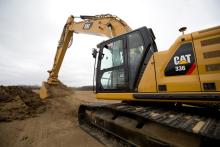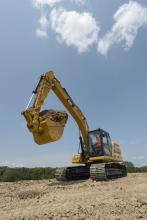The global excavator sector has expanded dramatically in recent years, driven by increased urbanisation. Liam McLoughlin reports - in our sister title Aggregates Business.
Despite the excavator industry recovering from a construction slowdown over the last six years, Volvo Construction Equipment (CE) says it is set to break its highest ever excavator sales record this year.
The Swedish manufacturer adds that, in part, this is down to the sheer versatility that these machines provide: from the mini excavators to the 95tonne mining machines, they offer the broadest possible options for any construction job. A further driver of the market boom is growing urbanisation in emerging economies such as China and India, according to Volvo CE’s vice president of excavator business platform Sungmo Yang.
“While the market continues to do well in Europe and North America – where compact excavators sell in huge volumes – it is within these developing countries that there has been a marked increase,” says Yang.
Yang adds that opportunities to capitalise on this urban growth are a boon to the big equipment manufacturers. According to WWF (World Wide Fund for Nature), global investment in infrastructure is the highest it’s ever been, with an estimated US$350 trillion (€299 trillion) set to be steered towards infrastructure over the next 30 years.
Customers are looking for the latest technology to improve productivity and reduce their environmental impact. In cities like London and Paris, there is already a movement towards banning diesel, and Yang says Volvo CE sees electromobility as one area that will drive the excavator market forward. Volvo has developed prototypes such as the EX2 fully electric compact excavator to show the potential for zero-emission electric excavators in the future.
Away from market conditions, a number of new models have recently been launched by major global OEMs.
Caterpillar has introduced two new next-generation 36tonne size class excavators — the 336 and 336 GC. The US OEM says they increase operating efficiency, lower fuel and maintenance costs, and improve operator comfort compared to previous models. The new excavators offer novel combinations of features designed to match contractors’ productivity and cost targets.
The Cat 336 features standard integrated Cat Connect Technology and the greatest power and lift capacity of the two models.
The Cat 336 GC combines a balance of productivity features with reduced fuel consumption and maintenance costs and is designed to provide high reliability and low-cost-per-hour performance.
Caterpillar claims that its Integrated Cat Connect Technology increases operating efficiency by up to 45% over traditional grading operations.
The standard Cat Grade with 2D system provides guidance for depth, slope, and horizontal distance to grade through the standard touchscreen monitor, making operators more accurate. The system is readily upgradable to Cat Grade with Advanced 2D or Cat Grade with 3D.
Standard Grade Assist automates boom, stick, and bucket movements so operators can stay on grade with single-lever digging.
Cat Payload delivers precise load targets and increased loading efficiency with on-the-go weighing and real-time payload estimates without swinging to prevent truck over/underloading.
The E-fence feature prevents the excavator from moving outside operator-defined set points —particularly useful when working beneath structures or near traffic.
Cat LINK hardware and software connect jobsites to the office and provide customers with machine-critical operating information.
Caterpillar says that, by design, Cat Next Generation excavators consume less fuel than the models they are replacing — up to 15% less fuel for the 336.
New Smart mode operation automatically matches engine and hydraulic power to digging conditions, optimising both fuel consumption and performance. Engine speed is automatically lowered when there is no hydraulic demand to further reduce fuel usage.
The cooling system features a new fan that runs on demand to keep the excavator working at the correct operating temperature for maximum efficiency.
With a new electrohydraulic system built for responsiveness and efficiency, the Cat 336 and 336 GC feature a new main control valve that eliminates the need for pilot lines, reduces pressure losses, and lowers fuel consumption. Fewer hydraulic lines on the excavators result in less oil required, lowering long-term operating costs.
Offering extended and more synchronised maintenance intervals, Caterpillar says the new Cat excavators do more work at a lower cost and reduce maintenance costs by up to 15% over the previous series.
The new Cat air filter with integrated pre-cleaner and primary and secondary filters has double the dust-holding capacity of the previous design.
The new Cat hydraulic return filter has a 3,000-hour service life — said to be a 50% increase on its predecessor.
The fuel system filters are synchronized for service at 1,000 hours — a 100% increase on previous filters.
The fuel system water and sediment drains and hydraulic system oil level are positioned close together at ground level, making routine daily maintenance faster, easier, and safer.
With a choice of Comfort, Deluxe, or Premium cab packages, all Next Generation Cat excavator cabs come equipped with standard features like keyless push-button start, large standard 8-inch (203mm) touchscreen monitor with jog dial keys for control, and sound-suppressed rollover protective structures to offer increased operator comfort and safety.
A tilt-up console for the Deluxe and Premium cab designs enables easy cab entry and exit. New advanced viscous mounts reduce cab vibration by up to 50% over previous models. Meanwhile, a Bluetooth integrated radio with USB ports for connecting and charging phones is said to bring home-style comforts to the operator’s office.
Other eye-catching Deluxe and Premium cab features are automatic climate control to maintain internal cab temperature settings, regardless of external ambient temperatures; programmable joystick buttons for response and pattern allow the operator to “dial in” productivity settings; and large front, rear, and side windows to enhance visibility. Optional 360-degree visibility (336 model only) combines images from multiple machine-mounted cameras to enhance the operator’s sight lines in all directions.
JCB has rolled out the advanced new 220X crawler excavator - the first in its next generation of tracked machines for the global construction market.
The new machines feature a larger cab with integral rollover protective structure (ROPS), offering reduced noise levels.
The focus has been placed on the operator environment, and the cab is a completely new structure, which will be used across the X series range. It is 100mm longer and a full one metre wide, making it 15% larger overall than on previous machines. The cab also has flat glazing all round. JCB says the 220X has an “incredibly low” 67dB(A) noise level inside the operator’s cab, down from 73dB(A) on the previous generation.
Inside the cab, the controls have all been ergonomically designed to be 100% operator-focused. To the right-hand side of the operator is an all-new command pod, bringing together all switches and controls into a single seat-mounted unit.
By combining the benefits of the screen and the command pod, which has a button for every regularly used function, JCB says tests have shown that an operator can carry out regular operations faster. The foot pedals, foot rests and tracking levers have also been redesigned to provide increased comfort.
The new 20-tonne class excavators are designed with an emphasis on durability and reliability. They have an upper structure that is now a full 2.7metres wide, 200mm broader than their predecessors.
The additional space has allowed JCB’s designers to mount the main boom in the centre of the machine, rather than at an offset. This reduces stress on the slew bearing and provides increased accuracy for the operator when trenching. It also permits the use of larger buckets without impacting the tracks.
To the right of the machine the handrail has been mounted in-board of the structure to prevent damage. However, if handrails are caught, they are now bolted in place, so can easily be replaced.
On the left-hand side of the body there is an air inlet in just one access door, cutting external noise levels. A large cooling pack with wide-core radiators as standard, comes with a removable fly-screen that is easy to keep clean.
While much of the last decade has, for all manufacturers, put engine development at the centre of the engineers’ brief, JCB says the stability of Tier 4 Final and Stage IV legislation has allowed its team to expand their remit for the new models.
JCB has stayed with proven Kawasaki hydraulic pumps and Kayaba valves, but has opted for larger spools and a latest generation valve block for reduced hydraulic losses. The diameter of the main hydraulic hose to and from the main hydraulic valve has increased in diameter from 19-25mm, giving greater flow without increasing the speed of the oil.
Following a collaboration between JCB and Topcon Positioning Group, the Topcon X-53x 3D machine guidance system is available as a plug-and-play option for the 220X crawler excavators. The companies will also provide customers with technical support throughout their extensive dealer networks.





